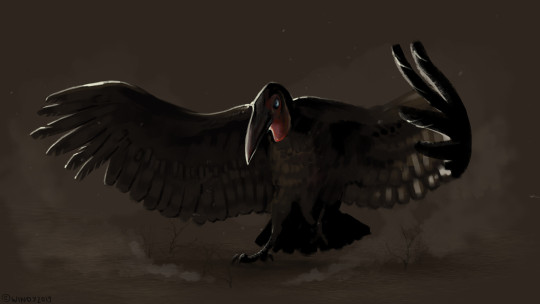#animabri
Text
Animabri

“Southern ground hornbill” © ArtStation user “Reptile without any name”. Accessed at their ArtStation here
[Animabri appears in the creation myths of the Krachi people of Togo and Ghana; specifically, he is the first creature to kill humans. In Harold Scheub’s A Dictionary of African Mythology, Animabri is referred to as a “giant ground toucan”. Which is not a thing that exists, and if it did, wouldn’t exist in Africa. It’s a hornbill. So this entry pulls in some other ground hornbill lore from throughout Africa to round out what I could only find passing references to.]
Animabri
CR 9 CE Magical Beast
This great black bird has an oversized beak with a short crest at its base. Colorful patches of bare flesh mark its face, and hang from its neck in a wattle.
The animabris are sinister avian predators that resemble a ground hornbill the size of an elephant. They have powers over death and misfortune, and people where animabris roam are leery of even mundane hornbills. Although they are fully flighted, an animabri is not very agile in the air, so spends most of its time on the ground. Animabris have incredibly keen vision, and ignore invisibility and illusions. They use this in their pursuit of small game. “Small” in this case is proportionate to the animabri, so includes creatures such as antelope, wild pigs and people.
An animabri is shrouded by a perpetual aura of misfortune. Most creatures are cursed by its mere presence, making fighting back against such a beast difficult. This curse of misfortune is temporary, but a well-placed peck or claw can bestow a more permanent curse on an enemy. Victims slain by an animabri have their souls severed from their bodies, making them harder to raise from the dead. Incorporeal undead tend to be more common than usual in animabri country, although the monstrous birds do not associate with such restless spirits.
Most animabris live in social units consisting of a single family—a mated pair and their adult children. These families are insular and clannish. They fight to the death with other animabris over hunting territory. Only when the parents grow old does the family split up, each member trying to find a mate to start its own little clan. Despite their group living, they are more competitive than cooperative when it comes to foraging, and may bicker over a choice meal or trinket. Animabris are interested in treasure, but have little idea of value. Their hoards contain the most brightly colored and shiniest objects they can find, regardless of their actual worth.
An animabri can live around 40-50 years. They can speak Common, which they use primarily to deliver threats and boasts.
Animabri CR 9
XP 6,400
Init +7; Senses darkvision 60 ft., low-light vision, Perception +21, true seeing
Aura misfortune (30 ft., DC 17)
Defense
AC 23, touch 13, flat-footed 18 (-2 size, +4 Dex, +1 dodge, +10 natural)
hp 115 (11d10+55)
Fort +12, Ref +11, Will +9
DR 10/magic; Immune curses, death effects, negative energy, patterns, phantasms
Offense
Speed 30 ft., fly 50 ft. (poor)
Melee bite +15 (2d6+6/19-20 plus grab), 2 claws +15 (1d6+6)
Space 15 ft.; Reach 10 ft.
Special Attacks cursed critical, sever life
Statistics
Str 22, Dex 19, Con 21, Int 8, Wis 19, Cha 14
Base Atk +11; CMB +20 (+24 grapple); CMD 34
Feats Critical Focus, Dodge, Improved Critical (bite), Improved Initiative, Multiattack, Power Attack
Skills Fly +6, Perception +21; Racial Modifiers +8 Perception
Languages Common
Ecology
Environment warm forests and plains
Organization solitary, pair or party (3-6)
Treasure incidental
Special Abilities
Aura of Misfortune (Su) All creatures within 30 feet of an animabri must succeed a DC 17 Will save or be cursed with misfortune, rolling all d20 rolls twice and taking the worse result. This effect lasts for as long as the creature remains within 30 feet of the animabri, and for 1d4+1 rounds thereafter. A creature that succeeds its save is immune to that animabri’s aura of misfortune for the next 24 hours. This is a curse effect, and the save DC is Charisma based.
Cursed Critical (Su) If an animabri successfully confirms a critical hit against an opponent, that creature must succeed a DC 17 Will save or be cursed (as per bestow curse—the animabri chooses the effect). The save DC is Charisma based.
Sever Life (Su) A creature that is killed by an animabri is difficult to return to life; such a creature can only be raised or resurrected with a successful DC 24 caster level check. This is a curse effect.
True Seeing (Su) An animabri gains the constant benefits of a true seeing spell as a supernatural ability.
66 notes
·
View notes